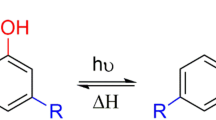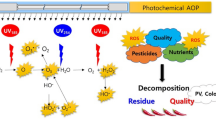Abstract
Photolysis may be a significant route of pesticide dissipation on crops, leading to an increase of pesticide use. Spraying strong absorbing compounds (photoprotector) along with pesticide is an attractive strategy to prevent the photodegradation phenomenon. The aim of this study is to get a better understanding of the parameters governing the photoprotection efficiency. Experiments were conducted using formulated sulcotrione as a pesticide and a grape wine extract as a photoprotector. These compounds were irradiated using simulated solar light as dried deposits on carnauba wax films or on disks of tobacco leaves and analyzed by ultra performance liquid chromatography ultraviolet (UV), spectroscopy, and microscopy. It is shown that photolysis is faster on leaves than on carnauba wax and that the photoprotection effect of grape wine extract is more efficient on leaves than on wax. Images recorded by microscopy bring evidence that deposits are very different on the two supports both in the absence and in the presence of the photoprotector. The grape wine extract plays a double role; it is antioxidant and UV screen. Photoprotection by the grape wine extract is a complex mixing of UV screen and antioxidant effects. The UV screen effect can be rationalized by considering the rate of light absorption by sulcotrione. Our results demonstrate that the rates of sulcotrione phototransformation are mainly governed by the repartition of the deposit on the solid support.








Similar content being viewed by others
References
Aaron JJ, Oturan MA (2001) New photochemical and electrochemical methods for the degradation of pesticides in aqueous media. Environmental applications. Turk J Chem 25:509–520
Andreu V, Pico Y (2004) Determination of pesticides and their degradation products in soil: critical review and comparison of methods. Trends Anal Chem 23:772–789
Bansal OP (2012) Degradation of pesticides. In: Rathore HS, Nollet LML (eds) Pesticides evaluation of environmental pollution, 1st edn. Taylor & Francis Group, New York, pp 55–68
Burrows HD, Canle LM, Santaballa JA, Steeken S (2002) Reaction pathways and mechanisms of photodegradation of pesticides. J Photochem Photobiol B 67:71–108
Deegan RD, Bakajin O, Dupont TF, Huber G, Nagel SR, Witten TA (1997) Capillary flow as the cause of ring stains from dried liquid drops. Nature 389:827–829
Durand G, Barcelo D, Albaiges J, Mansour M (1991) On the photolysis of selected pesticides in the aquatic environment. Toxicol Environ Chem 31:55–62
Eyheraguibel B, Richard C, Ledoigt G, ter Halle A (2010) Photoprotection by plant extracts: a new ecological means to reduce pesticide photodegradation. J Agric Food Chem 58:9692–9696
Eyheraguibel B, Richard C, Ledoigt G, ter Halle A (2011) Inhibition of herbicide photodegradation by plant products. J Agric Food Chem 59:4868–4873
Fadaei AM, Dehghani MH, Mahvi AH, Nasseri S, Rastkari N, Shayeghi M (2012) Degradation of organophosphorous pesticides in water during UV/H2O2 treatment: role of sulfate and bicarbonate ions. E-J Chem 9:2015–2022
Franko M, Sarakha M, Cibej A, Boskin A, Bavcon M, Trebse P (2005) Photodegradation of pesticides and application of bioanalytical methods for their detection. Pure Appl Chem 10:1727–1736
Katagi T (2004) Photodegradation of pesticides on plant and soil surfaces. Rev Environ Contam Toxicol 182:1–195
Kiss A, Virag D (2009) Photostability and photodegradation pathways of distinctive pesticides. J Environ Qual 38:157–163
Kromer T, Ophoff H, Stork A, Führ F (2004) Photodegradation and volatility of pesticides. Environ Sci Pollut Res 11:107–120
Monadjemi S, El Roz M, Richard C, ter Halle A (2011) Photoreduction of chlorothalonil fungicide on plant leaf models. Environ Sci Technol 45:9582–9589
Navarro S, Fenoll J, Ruiz N, Navarro G (2009) Photocatalytic degradation of eight pesticides in leaching water by use of ZnO under natural sunlight. J Hazard Mater 172:1303–1310
Segal-Rosenheimer M, Dubowski Y (2008) Photolysis of thin films of cypermethrin using in situ FTIR monitoring: products, rates and quantum yields. J Photochem Photobiol A 200:262–269
Shen X, Ho CM, Wong TS (2010) Minimal size of coffee ring structure. J Phys Chem B 114:5269–5274
ter Halle A, Drncova D, Richard C (2006) Phototransformation of the herbicide sulcotrione on maize cuticular wax. Environ Sci Technol 40:2989–2995
ter Halle A, Piquet A, Richard C (2007) An actual scenario that demonstrates sulcotrione photodegradation on maize leaves after spraying. Environ Chem 4:256–259
ter Halle A, Wiszniowski J, Hitmi A, Ledoigt G, Bonnemoy G, Bonnet JL, Bohatier J, Richard C (2009) Photolysis of the herbicide sulcotrione: formation of a major photoproduct and its toxicity evaluation. Pest Manag Sci 65:14–18
Texier I, Gianotti C, Malato S, Richter C, Delaire J (1999) Solar photodegradation of pesticides in water by sodium decatungstate. Catal Today 54:297–307
Thomas JP, Bejjani A, Nsouli B, Gardon A, Chovelon JM (2008) Investigation of norflurazon pesticide photodegradation using plasma desorption time-of-light mass spectrometry analysis. Rapid Commun Mass Spectrom 22:2429
Yu B, Zeng J, Gong L, Zhang M, Zhang L, Chen X (2007) Investigation of the photocatalytic degradation of organochlorine pesticides on a nano-TiO2 coated film. Talanta 72:1667–1674
Acknowledgments
The authors wish to thank Dr. Pascale Goupil, Razik Benouaret, and Dr. Marc Saudreau (UMR PIAF-547UBP/INRA, Université Blaise Pascal, Clermont-Ferrand) for their advises on biological materials and droplet–surface interactions, respectively. Authors thank FUI (Fonds Unique Interministériel, France) for financial support and for having granted the post-doctoral position of A. Trivella through Phytomarc project (1105001E).
Author information
Authors and Affiliations
Corresponding author
Additional information
Responsible editor: Leif Kronberg
Rights and permissions
About this article
Cite this article
Trivella, A., Richard, C. New insights into pesticide photoprotection. Environ Sci Pollut Res 21, 4828–4836 (2014). https://doi.org/10.1007/s11356-013-1490-7
Received:
Accepted:
Published:
Issue Date:
DOI: https://doi.org/10.1007/s11356-013-1490-7




